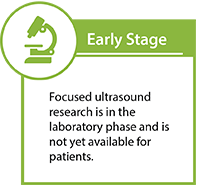Focused Ultrasound Therapy
Focused ultrasound is a noninvasive, therapeutic technology with the potential to improve the quality of life and decrease the cost of care for patients with neuromyelitis optica, (also known as Devic’s Disease) which is an autoimmune, inflammatory, demyelinating disease of the central nervous system (CNS). This novel technology focuses beams of ultrasound energy precisely and accurately on targets in the CNS without damaging surrounding normal tissue.
How it Works
Where the beams converge, the ultrasound produces a temporary opening of the blood-central nervous system barrier (similar to the blood-brain barrier) which allows the delivery of remyelinating cells and an antibiotic, which can decrease the severity of the disease. All of this can occur without any surgery. While early preclinical results are promising, there is still much to be done before this technology will be widely available for patients.
Advantages
The primary options for treatment of neuromyelitis optica include plasmapheresis, but this is temporary, and patients typically have recurrent disease and eventual disability. There is no cure for the disease.
For certain patients, focused ultrasound could provide an improved treatment option for this otherwise debilitating disease. Focused ultrasound has less risk of complications – such as surgical wound healing or infection. It can reach the desired target without damaging surrounding tissue and is repeatable, if necessary.
Clinical Trials
At the present time, there are no clinical trials recruiting patients for focused ultrasound treatment of neuromyelitis optica.
Regulatory Approval and Reimbursement
Focused ultrasound treatment for neuromyelitis optica is not yet approved by regulatory bodies or covered by medical insurance companies.
Notable Papers
Yao X, Adams MS, Jones PD, Diederich CJ, Verkman AS. Noninvasive, Targeted Creation of Neuromyelitis Optica Pathology in AQP4-IgG Seropositive Rats by Pulsed Focused Ultrasound. J Neuropathol Exp Neurol. 2018 Nov 30. doi: 10.1093/jnen/nly107.
Click here for additional references from PubMed.

